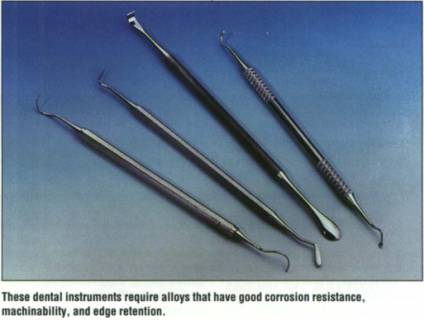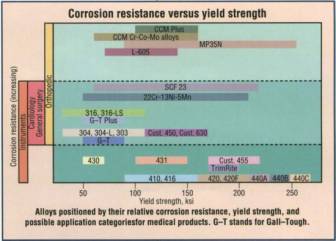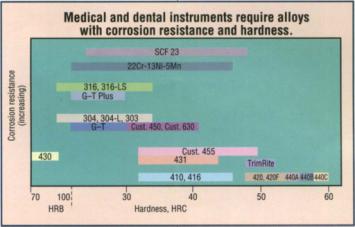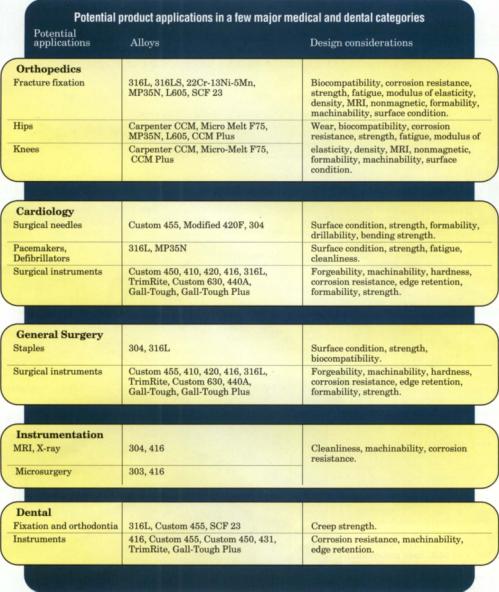Unique Properties Required of Alloys for the Medical and Dental Products Industry
White Papers
Unique Properties Required of Alloys for the Medical and Dental Products Industry
Alloys for medical and dental products must have an exceptional range of properties to meet the increasingly demanding manufacturing requirements and service conditions of this growing industry.
Many different grades have been used successfully for the more common applications in orthopedics, cardiology, general surgery, instrumentation and dentistry. With advancing technology and the imposition of more challenging conditions, however, the need has arisen for newer, more specialized alloys.

Designers and fabricators need to be aware of all candidate materials and their performance characteristics if they are to make a wise choice. Criteria for making this selection will be offered in the following text and diagrams.
Generally, alloys are selected on the basis of their corrosion resistance, yield strength, toughness, fatigue strength, hardness or wear resistance. In some instances, an application may require a combination of two or more of these properties, with each reaching an acceptable level of performance. Many times it may be necessary to evaluate several alloys because no single alloy can provide universal service.
The diagram in Fig. 1, for example, positions key alloys to show their relative corrosion resistance and yield strength. Corrosion resistance increases from the bottom to the top of the diagram, and yield strength increases from left to right.
This diagram shows the relationship between corrosion resistance and yield strength of alloys that might be considered for applications to the left. Yield strength is charted in terms of ksi across the bottom. The bars on the chart show the approximate range of strength offered by each alloy at its given level of corrosion resistance.
The diagram indicates that stainless CarTech 410, CarTech 416, CarTech 420, CarTech 420F, CarTech 440A, CarTech 440B and CarTech 440C possess the lowest level of corrosion resistance. The strength of these alloys increases moving left to right.
Reading the same diagram, it can be seen that a new alloy known as CarTech BioDur® CCM Plus® alloy provides the greatest corrosion resistance, followed by the CarTech BioDur CCM (Cr-Co-Mo) alloys and, at a significantly higher strength level, CarTech MP35N[1]. All of the other alloys provide different combinations in their degree of corrosion resistance and yield strength.

Fig. 1 - Corrosion Resistance vs. Yield Strength
relationship between corrosion resistance and hardness.

Fig. 2 - Relationship between corrosion resistance and hardness Conditions unique to the industry may force materials specifiers to re-examine factors affecting corrosion resistance. Changing autoclaving techniques, for example, present a challenge in selecting a duly resistant alloy. Many who employ the newer techniques have found that stainless CarTech 410, CarTech 420 and CarTech 440A -alloys long used for medical and dental instruments - now lack sufficient resistance to attack. Thus, alloys such as CarTech BioDur TrimRite® stainless or CarTech BioDur Custom 455® stainless should be considered.
Those who are seeking wear resistance must be reminded that this property is not purely dependent on hardness. Martensitic quench-and-temper alloys like stainless CarTech 410, CarTech 420, CarTech 440 and CarTech BioDur TrimRite stainless have better wear resistance than the precipitation hardening stainless steels at the same hardness level.
Manufacturers of dental and surgical instruments have experienced problems with cutting edge retention that can be alleviated with modified practices and/or selecting a new alloy. One potential cause of edge retention problems may lie in the sharpening techniques. Over tempering of the steel can occur at the edge during high speed production sharpening. This would lower the hardness of the steel, and therefore cause poor edge retention. The manufacturer can solve this problem by modifying his sharpening practice. He should grind at slow rather than high speeds, and use water to cool the edge during sharpening. In addition to making this change, the manufacturer might consider a material such as CarTech TrimRite, which is more resistant to tempering.
Specialty Alloys
Medical products designers and manufacturers now have at their disposal a number of specialty alloys which they can use to overcome some of their historic problems.
CarTech TrimRite stainless (UNS-S42010) was specifically designed to provide the attributes needed for cutting and scraping instruments. It has better corrosion resistance than Types 420 and 440A stainless steels, improved resistance to tempering during edge sharpening, superior cold formability, and improved ductility and toughness at HRC 50.
CarTech TrimRite stainless is a hardenable martensitic stainless steel with the following typical analysis: 0.22% carbon, 14.0% chromium, 0.55% nickel, 0.60% molybdenum, 0.5% manganese, 0.35% silicon, 0.005% sulfur and balance iron.
Another new alloy known as CarTech Gall-Tough® stainless (UNS-S20161) provides much better resistance to galling and metal-to-metal wear than stainless CarTech 304, with comparable corrosion resistance. This property allows more flexibility in designing instruments and devices with moving parts. The alloy also displays higher annealed yield strength than CarTech 304 stainless.
CarTech Gall-Tough stainless is a high-silicon, high-manganese, nitrogen strengthened austenitic stainless steel with the following typical analysis: 0.10% carbon, 16.2% chromium, 5.2% nickel, 5.5% manganese, 3.5% silicon, 0.025% sulfur, 0.12% nitrogen and balance iron.
A new, more highly corrosion resistant variation of this alloy, called CarTech Gall-Tough PLUS® stainless (UNS No. applied for) offers similar self-mated galling and metal-to-metal wear resistance, but with corrosion resistance similar to that of Type 316 stainless steel. It provides the attributes required for adjustable fasteners and devices that are exposed to more corrosive environments.
Typical analysis of CarTech Gall-Tough PLUS stainless is: 0.1% carbon, 18.0% chromium, 8.0% nickel, 1.0% molybdenum, 5.5% manganese, 3.5% silicon, 0.025% sulfur, 0.18% nitrogen and balance iron.
CarTech BioDur CCM PLUS® alloy is an upgrade of the popular chrome-cobalt-moly (CCM) alloys used for implantable orthopedic devices. This alloy's excellent homogeneity and fine microstructure are achieved through unique processing at Carpenter. It consequently has a higher annealed strength, as well as more uniform mechanical and physical properties.
The requirements of ASTM F799 can be met more easily with this material because it is not necessary to work at reduced forging temperatures. This production versatility enables the manufacturer to make a wider variety of sizes and shapes when producing orthopedic devices and implants for hips, knees and other joints.
CarTech BioDur CCM PLUS alloy provides the full range of properties typically required for many orthopedic implant applications - high strength, excellent corrosion resistance, biocompatibility and bearing qualities.
Typical analysis for the alloy: 0.30% carbon, 28.5% chromium, 0.3% nickel, 5.5% molybdenum, 0.5% manganese, 0.60% silicon, 0.002% sulfur, 0.20% nitrogen, 0.3% iron and balance cobalt.
Two other specialty alloys provide unique properties that have been found useful in the medical and dental products industry. CarTech Custom 450® stainless (UNS-45000) has corrosion resistance similar to stainless CarTech 304, but it can develop higher strength, with good ductility and toughness, by means of a simple heat treatment, as opposed to cold working.
These characteristics offer the fabricator two important advantages. First, he can fabricate the material in the annealed, softer condition. Second, the strength required for the application can be achieved then by means of a simple, single step, low temperature heat treatment.
Typical analysis of CarTech Custom 450 stainless is: 0.03% carbon, 14.7% chromium, 6.5% nickel, 0.8% molybdenum, 1.5% copper, 0.3% manganese, 0.4% silicon, 0.002% sulfur, 8 x C minimum columbium and balance iron.
Like CarTech Custom 450 stainless, CarTech Custom 455® stainless (UNS-S45500) is also a martensitic, age-hardenable austenitic alloy. This stainless steel can develop multiple strength levels simply by using different heat treating schedules, with no distortion problems as a bonus. With its unique combination of corrosion resistance, similar to CarTech 430 stainless, and high strength, the alloy is an excellent candidate for very small instruments that grip at the working end of endoscopic instruments.
Typical analysis for CarTech Custom 455 stainless: 0.09% carbon, 11.5% chromium, 8.3% nickel, 2.0% copper, 0.25% manganese, 0.25% silicon, 0.005% sulfur, 1.2% titanium, 0.21% columbium and tantalum, and balance iron.
Design Considerations
The medical and dental products industry uses a multitude of different alloys, either for finished products or for the tools and dies needed to fabricate parts and components. Some alloys - those identified in the middle column of Fig. 3 - are used more frequently than others.
The alloys are grouped in this chart to suggest their potential application (left column) in areas such as orthopedics, cardiology, general surgery, instrumentation and dentistry. They are also aligned with key design considerations (right column) as candidate alloys to meet those special requirements.

Fig. 3 - Alloys which have been used by the medical industry.
Using the chart, a designer simply needs to locate the type of application that interests him or her, then evaluate the candidate alloys for that type of application to determine whether they have the properties to meet all the design criteria.
When the design needs are critical, perhaps likely to test the limits of familiar alloys, the designer could benefit by discussing his specific requirements with a specialty alloys manufacturer. A number of the newer, as well as standard alloys used today stem from two-way discussions of difficult materials needs.
Summary
The medical and dental products industry consumes a wide range of products made from metals. Historically, there has been relatively little change in the metals used for most applications. This trend, however, is changing as designers and manufacturers face new materials challenges.
The alloys highlighted in this article offer a number of unique advantages for specific applications. When considering one of these materials for use, it is suggested that the application be discussed with the metals manufacturer to insure that the requirements of the application and the attributes of the metal are fully understood.
***
By Robert S. Brown
Carpenter Technology Corporation
Reading, PA
USA